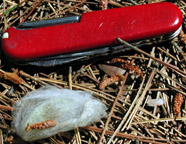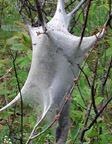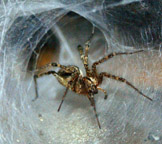Webs and Cocoons
Many spiders and insects are able to spin webs and build other structures.
Silk Structures made by Insects
For example, tent caterpillars spin a large, web-like structure in a tree or other plant. The structure protects the developing larvae.
Some moths and butterflies spin their cocoons into a curled leaf to help protect themselves.
Spider Webs
You know there are many kinds of spiders, but did you know there are many kinds of spider webs? There are! And the cool thing is, the spider web is a big clue to the kind of spider that made it. When you know the different kinds of webs that spiders commonly make, you can make a pretty good guess about the kind of spider that left it.
The kind that you are probably most familiar with is made by Orb Spiders (Araneidae family). Their webs are shaped like spirals on lines. They are very beautiful. To maintain that beauty, orb spiders have to repair their webs at least once every day.
Triangle Spiders (Uloboridae family) make triangular webs. These webs sort of look like a slice of the webs make by orb spiders.
Funnel spiders (Agelenidae family) make very interesting webs that mightå look like a bird's nest made of silk. They make sheets of silk and wrap them up to make funnels. The funnels have one big opening to catch prey. They also have one small opening in the back in case the spider needs to escape. These webs are not actually sticky. The spiders that make them are just better at moving around in their smooth funnel shape.
Funnel spider webs aren't always cupped. They often make flat sheets with a small funnel-shaped retreat off to one side.
Cobweb spiders (Theriidae) make small, random messes of silk string that are attached to their surroundings by long strings. Cobweb spiders are also called comb-footed spiders.
Meshweb spiders (Dictynidae family) make webs that are similar to cobweb spiders but have a little more structure. The spiders are usually found in small, messy webs at the tips of vegetation, especially in grassy fields. They can also be found under stones and dead leaves.
Sheet web spiders (Linyphiidae) make many kinds of webs that are formed out of sheets of silk. The sheets are wildly jumbled together and don't have many large gaps.
There are several kinds of sheet web spiders. Platform spiders make thickly interwoven sheets of silk. Filmy dome spiders make dome shaped sheets that are secured by a network of silk strings. Bowl and doily spiders make very interesting webs. The tops of them look like bowls that are secured by strings to something above them. The bowl appears to be sitting on a doily that is the second part of the web and is attached horizontally. These kinds of webs make very effective booby-traps for unsuspecting insects.
Spider webs are a sign that spiders have been nearby, but they aren't the only signs. Spiders also spin webs to protect their eggs and developing young. These egg cases look like eggs but actually contain hundreds of tiny spider eggs.
Some spiders don't make webs. These spiders do use silk to make a little hiding place for themselves, especially females with eggs.






